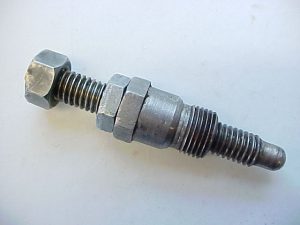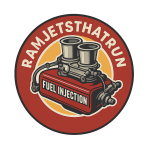It’s important to use top quality parts in your ignition system. I recommend installing a new Delco plug wire set. I never use those “properly dated” reproduction plug wires because of their tendency to misfire under load. I prefer to use new ignition coils rather than 40 – 50 year old GM originals. You can buy new plug wires from K&B Special Products near Atlanta. Their phone number is (770) 777-1031. The Pertronix 1.5 ohm coils fit in original Corvette coil brackets and work properly with a stock low-resistance ballast resister. An excellent spark plug available today for injected Corvettes is the Autolite #295. This plug is a non-resister design equivalent to the discontinued AC 46.
You can easily break the mounting ears on the 1963 – ’65 plenum feet by over-tightening. Do not apply more than 5 ft-lbs. of torque to the hold-down nuts when installing the plenum on the adapter manifold.
When replacing the ’63 – ’65 plenum cover seal, use a soft rubber reproduction version. Do not use a rigid seal like those installed by GM. A hard seal will not conform to the shape of the plenum and can cause the cover to crack when it is fastened down.
Use black RTV silicone sealer on the engine block at the ends of the adapter manifold rather than the pre-formed rubber or cork seals that come in intake manifold gasket sets. This reduces the risk of cracking the corners of the manifold. Tighten the manifold-to-head bolts to no more than 25 ft-lbs. I usually tighten the front bolt on each side to 5 ft-lbs. less than the others. Also, use silicone sealer around the water jacket openings in the cylinder heads where they mate to the adapter manifold.
Confirm that that the Top Dead Center mark on the harmonic balancer is properly matched to the “0” on the timing chain cover scale. Chevrolet offered high performance small block balancers with the timing mark in several different locations over the years. You can check the location of your TDC balancer mark by using a piston stop tool.
If your distributor has a vacuum advance canister, it should be disconnected while setting the timing. You should make sure the total amount of mechanical advance is 36 degrees at high rpm. You’ll probably find that 8 degrees of initial advance will give you 36 degrees total in a ’57 FI distributor. The ’58 – ’65 distributor initial timing when using either the Duntov “097” cam or the later “30-30” cam should be 12 – 16 degrees.
If you’re installing a 7017380 series unit, remember to plug the purple wire into the micro-switch. It also plugs into the ignition harness just above the windshield wiper motor. If you forget to install this wire, the engine will not start.
Check to make certain the throttle butterfly is fully open when the accelerator pedal is pressed to the floor. The accelerator linkage rod length is adjustable.
Make sure the bellcrank return spring is strong enough to fully close the throttle butterfly every time. Some reproduction pull-back springs are too weak to work properly.
If a quick first time start-up is important to you, pre-fill the fuel bowl through the top vent before installing the unit. You will have to remove the top fuel meter bracket and screen first in order to do this.
Modern gasoline has a relatively low boiling point compared to gas sold during the sixties. If you experience a rough idle due to percolation (gas boiling in the distribution spider), use undiluted racing gas instead of pump gas. Racing gas has a 50% boil-off temperature over 210 degrees. Aviation gas won’t fix a percolation problem. It has about the same 50% boil-off temperature as pump gas, which is often as low as 150 degrees. Blends of racing gas with pump gas don’t seem to help either.
After the engine has warmed up, hold the accelerator pedal at least 3/4 to the floor while turning the key to start. This prevents flooding.
Always start and drive your injected car at least once a month. Keep fresh gas in the tank. Pump gasoline has a shelf life of about one year. Racing gas has stabilizers that allow it to last much longer.
If your unit has a cranking signal valve, assume it will be the next FI part to fail. The primary symptom of CSV failure is an excessively rich fuel mixture.
Always carry a spare gear pump drive cable with you. You may never need one, but if you do break a drive cable on the road, your engine will not run until you replace it.

